The Graham Family: Scottish Migrants to Exmoor
The Friends of Hoar Oak are always pleased to learn more about any of the Scottish shepherd families who came to Exmoor. Recently we were contacted by Donald Graham, a descendant of Thomas and Marion Graham who came to Exmoor from Biggar in Scotland around 1875. Donald was born and brought up in and around Lynton and Brendon and has strong family links to the Rockford Inn, a favourite with many of The Friends of Hoar Oak Cottage. He now lives and works in Minehead.
The story Donald has to tell, the photographs he has to share and the memories he has provided about Thomas and Marion are a treasure trove of information. It is a story full of interest and adventure as well as fortitude combined with sprinklings of sadness and hardship. It takes us across the length of Britain, from Scotland to North Devon, involves several sheep farms on Exmoor including Badgworthy and Larkbarrow and ends in South Devon. The photo below is of Donald Graham on a recent walk out to his ancestors’ farm at Larkbarrow, where only a few walls and features of the old building now remain. He is holding a photo of Thomas and Marion Graham who left Scotland to come and live in this spot in the 1870s.

According to the family bible (still in Donald’s possession) – Thomas Graham was born on the 8th of July 1851 in Biggar, Lanarkshire. His mother was Janet Graham, but his father’s name is unknown. Thomas was christened Thomas Steel Graham and was brought up on his grandparents (John and Janet Steel Graham) sheep farm in Biggar, Lanarkshire with two other siblings. When, in 1856 his mother Janet died, Thomas continued to be raised by his grandparents whom, it is recorded, he remained very close to. His grandfather, John Graham was a shepherd and a drover and it is no doubt from him that Thomas learnt his shepherding skills. Sadly, Grandfather John came to a sticky end: a story which involves a flock of sheep, the House of Muir Sheep Market, whisky drinking and the Haystoune Arms in West Linton and which was reported in the Peebleshire Advertiser and County Newspaper dated 9th April 1864.
It recounts how John was found dead after leaving the pub in his usual good health and saying he was going to Dolphinton. He had three score sheep with him. The newspaper says “Dr Andrew Bonthorn on arriving found Graham lying on his right side, with his plaid under his head. He pronounced life to be extinct and gave it as his opinion that death had been caused by cold and exposure, after indulging in intoxicating drink, or that the exposure had accelerated some pre-existing disease.” Heart disease is inherent in the male line of the Grahams and it seems poor John succumbed.
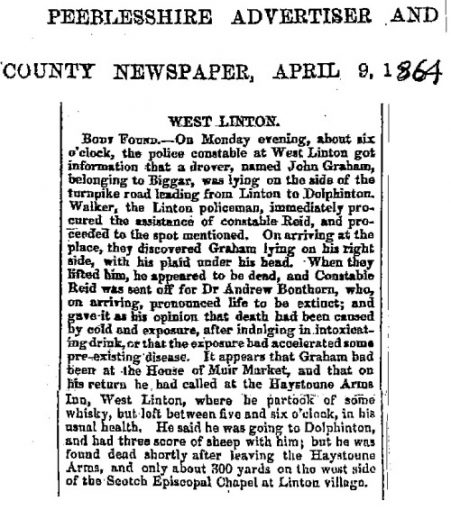
After John’s death his wife, Janet Steel Graham, was left not only to fend for herself but also to continue raising her dead daughter’s children. She must have indeed been a woman of steel and the fact the Steel name has come down through the family line is testimony to the high regard she was held in, including by her grandson Thomas who carried her memory to Exmoor.
On the 3rd June 1872, at the age of 22, Thomas Graham married Marion Wilson in Biggar. Although, at the moment, we do not know where they lived and worked initially, we do know that their first son, another Thomas Steel Graham, was born in 1874 at Broadlees, Symington just three miles from Biggar. In 1875 a second son, George Wilson Graham was born in Peebles. It may be that by this time the family had moved away from Biggar or that Marion’s family came from Peebles and she had returned home to have her baby.
The picture of the family below, taken when young George was still a toddler, shows the family in a photographer’s studio-type pose. There is a romantic backdrop and in the front, and obviously to the children’s delight, there is a little chicken perched on a fence in front of them. It is a lovely family photo and seems to have been taken in Scotland – perhaps just before they left for Exmoor.
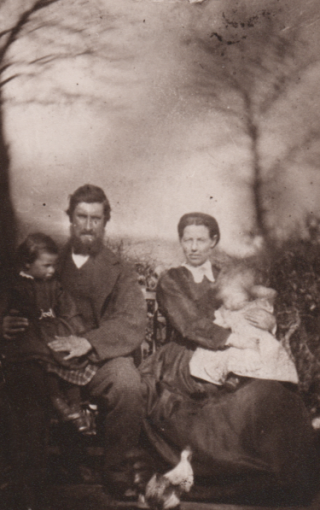
Thomas’ wife Marion has been remembered as a woman who was fiercely proud of her family and of her Scottish roots and family memories tell us that Marion brought this strong pride of home and family with her when she moved to Exmoor. The family travelled with a few prized personal possessions, their sheepdogs and a flock of Cheviot sheep, leaving by boat from Scotland to travel to Lynmouth in North Devon. We have yet to find out which port they left from, but we know from elsewhere that it was not in the least unusual for shepherds, their wives and children and the sheep to all travel south on the same ship – ships which were not very large and often overcrowded. The journey down the west coast of Scotland and England and then up the Bristol Channel to North Devon must have been an uncomfortable and taxing one. On arrival in Lynmouth, passengers and sheep would all be offloaded and the sheep driven up onto Exmoor by the shepherd and his sheep dogs. A horse and cart would have met the ship and transferred the women and children to their new home.
A photo of one of Marion’s precious possessions transported down to Exmoor still exists. It is of her “Scotch Dresser” and it is fascinating to imagine the family and their dresser bouncing along in a pony and trap along the lanes from Lynmouth up onto the moor. Also among their baggage was her most prized possession – an album in which Marion had compiled of photos of Biggar and the family in Scotland. We learn that she  was always willing to show off her album and talk about it to visitors. It would be wonderful to find out if that album maybe still exists – if you know of it do please get in touch – but for the moment it is possible to share a photo of Marion’s “Scotch Dresser”.
was always willing to show off her album and talk about it to visitors. It would be wonderful to find out if that album maybe still exists – if you know of it do please get in touch – but for the moment it is possible to share a photo of Marion’s “Scotch Dresser”.
Thomas Graham had most probably been employed by Frederic Knight to deliver a flock of Scottish sheep to Exmoor and to live and work as the shepherd at Larkbarrow. The farmstead was a substantial one but it was in a bleak and isolated part of Exmoor – by following this link the reader will be taken to a leaflet describing a walk to Larkbarrow as well as a little of the history of the farmstead.
Although it had begun to fall into slight disrepair by the mid-1800s Larkbarrow was, when the Grahams lived there, a substantial farmstead with extensive outbuildings. It was also, as can be seen in the photo below, in two parts allowing accommodation for extra farm labourers or in some cases another family. More can be found out about Larkbarrow in Roger Burton’s book The Heritage of Exmoor and the reader is recommended to take a look at that book if more information about Larkbarrow, or indeed any aspect of Exmoor heritage, is wanted. This lovely old farmhouse is now long gone as it was used by the Army for Tank Gunnery practice and the buildings were, quite literally, blown up.
For the Graham family, Larkbarrow was where their new life on Exmoor started and where their third child, a son called John Graham, was born on the 26th July 1878. The little boy died just 15 months later of diarrhoea exhaustion – an unpleasant condition but one which was not that unusual a cause of death at that time. On the 3rd October 1880 another daughter, Marion, was born followed by a further child, who was named Janet Steel Graham and born on the 17th June 1882. Another son, William Graham was born on the 13th November 1883 in Ashkirk, Roxburgh and it seems likely that Marion returned home to have this final baby whilst Thomas stayed behind to work. It also seems very likely that Marion took some, or perhaps all, of the other children with her as some of them were, in later life, still able to remember being taken to Scotland when their mother had another baby.
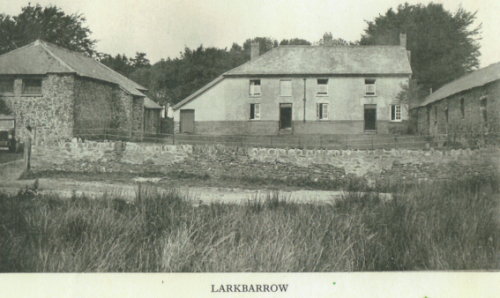
By 1887, the Graham family moved from Larkbarrow to another remote and even wilder spot on Exmoor, Badgworthy Farm. Living at Badgworthy was a rather different kettle of fish for the Graham family. It was a lonely and isolated building. A simple two-up, two-down cottage with a lean-to (probably for a pig) which had been built in the 1860s by John Bale and John Lethaby. It is alleged that they used stones from the old ruined cottages known as the Doone Huts – the remains of a ruined medieval village and linked to the great Exmoor tale by RD Blakemore of Lorna Doone. Badgworthy – sometimes called the Shepherds Cot – was recorded as having a “feel” to it which many occupants did not like. Another Scottish family, the William Johnstone family, lived and worked there in the 1870s and stayed just a few years before returning to Scotland.
The building was whipped by the wind, it would have been a terrible place in the snow and apparently echoed (to those who could hear such things) with the noises of the men – some might call them the ‘blaggards’ – who had once lived there, supposedly in robber gangs. Badgworthy is noted as having the highest turnover of occupants during the period when Knight housed his shepherds/farmers there. Although we shall never know exactly why this should be the case it is, nonetheless, remembered as a place that people generally did not seem to have enjoyed living in.
The photos below show it in its setting and help tell the story of Badgworthy. The first photo shows the cottage with smoke pouring horizontally out of the chimney and with the few stone walled enclosures to the back and side of the cottage, where the family would have tried to grow some crops or to protect sheep and perhaps a pony and cow or two.
The second photo was used in a Judges postcard and demonstrates the bleakness of Badgworthy setting. It also shows how oats were grown in the field across the valley and the crop can be seen here, gathered into stooks, waiting to be collected and stored for winter. The entire plant – straw and oat head – would be fed to the animals.
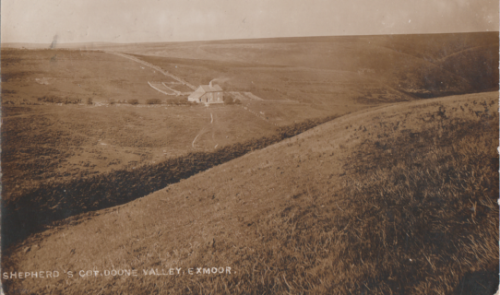
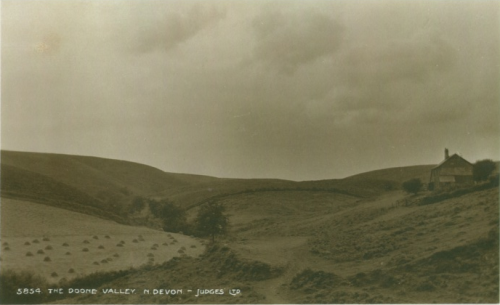
The next photo is a wonderful, personal memento of the Graham’s time at Badgworthy. It is of the Graham children and visiting friends out on the moor to the front of the cottage. How lovely it would be to learn which are the Graham children and who the friends are.
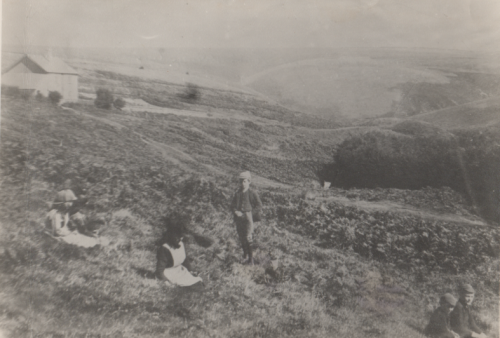
The Graham family’s move from Larkbarrow to Badgworthy was recorded in Head Shepherd Robert Tait Little’s diary for 1888. Head Shepherd Little was employed by the Knight family and came from Scotland to take up this important post. He kept detailed and extensive records about the sheep, sheep breeding, quantities of wool and meat sold to market etc. Although the diaries are intended to be primarily stock records they also give tantalising glimpses of which shepherd was at which herding at any particular time between 1870 and 1907. The image below gives two pages from one of the Little’s diaries covering the years 1885 to 1890 which record exactly that information. These pages are from 1888.

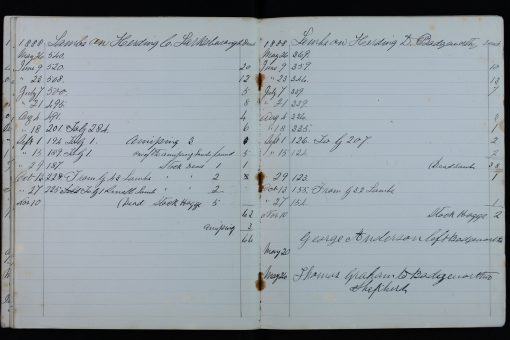
Down at the bottom of the right-hand page it is recorded:
May 20th, George Anderson left Badgeworthy
May 26th, Thomas Graham to Badgeworthy Shepherd.
This diary entry gives us a precise window when the Grahams left Larkbarrow and moved to their posting at Badgworthy. It also casts light on one of the intriguing aspects of the Scottish shepherds on Exmoor story, the degree to which the Scottish shepherd families were related to each other or had strong interconnections back in Scotland. Donald Graham tells us that Thomas Graham who came to Exmoor from Scotland had an Aunt Elizabeth who was married to William Anderson back in Biggar. And here in Robert Tait Little’s diary we see a shepherd Anderson handing over to Thomas Graham at Badgworthy in 1888. It may well be the case that “word of mouth”about shepherding jobs on Exmoor meant two branches of the family – the Grahams and the Andersons – both ended up down in North Devon. Perhaps the Thomas Graham and George Anderson recorded on these diary pages were cousins?
Our knowledge about the family ties between so many of the Scottish shepherd families on Exmoor continues to grow and it would be wonderful to find any descendants of George Anderson as they may hold some clues to this particular little mystery about whether the Andersons and Grahams on Exmoor were indeed related.
Perhaps it was with some relief that the Graham family moved away from Badgworthy. For the moment, the date of this move is unknown, but it is very likely to have coincided with the period towards the end of the 19th century when the land and cottages on Exmoor had been sold by the Knight family to the Fortescue Estate and were being run by Lord Ebrington, a Fortescue son. His aim was not to continue employing shepherds but to let the farms and land for shooting etc. and to earn income from them in that way. The Exmoor Scottish sheep farming experiment was coming to a close and many of the shepherds hired from Scotland lost their jobs, their homes and their livelihoods. For some the loss of livelihood and home was a bitter blow, see for example the story of William Davidson. For others, with well-established links to the area and their children already married into local families, the desire to return to Scotland must have been lessened and they would, as in the case of the Grahams, look for work elsewhere.
Ultimately, the Graham’s home at Badgworthy suffered the same fate as several other hill farm cottages on Exmoor (including their other home at Larkbarrow) as it was used by the Army for tank gunnery practice and demolished. The photos below were taken in July 2015 and show the sad remains.
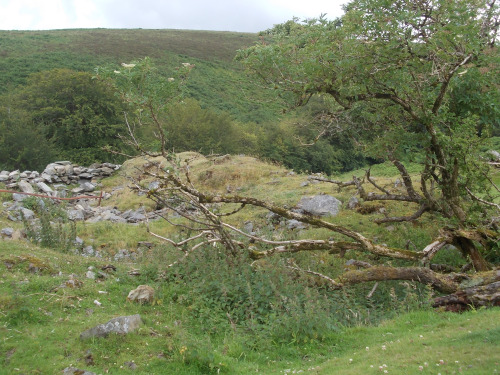
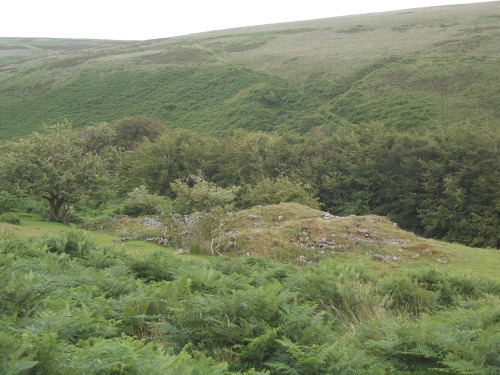
Thomas and Marion Graham moved from Badgeworthy Cottage to Kipscombe Farm in Countisbury to work, it seems most likely, for Sir William Halliday of the Glenthorne Estate. The 1901 census, however, finds Thomas and Marion at Twitchen Farm in Challacombe so their time at Kipscombe must have been fairly short and confined to 1889/1900. Family memories suggest they moved to Challacombe because of its thriving Methodist chapel and community.
Thomas Graham had a reputation as a gifted and fiery speaker in the local Methodist Chapel at Brendon. He had been raised with a strong Christian faith in the Church of Scotland and he is remembered for reading to his children from the old family bible brought from Scotland. He became a lay preacher and would preach at Brendon and other local Methodist churches on Exmoor. Methodism was the nearest non-conformist religious style to the Church of Scotland and many, if not all, of the Scottish shepherd families would have attended a Methodist chapel in and around Exmoor. Thomas Graham is remembered for having a strong Scots accent and his descendants wonder how well this fiery and charismatic Scottish Preacher would have been understood by the natives of the Brendon Valley.
Their daughter Marion Graham was attending the Methodist Chapel at Challacombe even when the family were still living at Kipscombe. It would have been a long trek to get to chapel meetings and perhaps a blow to her father who was still preaching at the Methodist Chapel in Brendon – but perhaps there is a better explanation that is still to be learnt. Nonetheless, the attractions of Challacombe eventually tempted the entire family to move there and to take up residence at Twitchen Farm. The village had a shop, post office, baker and blacksmith as well as a pub (which would not, of course, have been frequented by this staunchly Methodist family) and this would have been the first time since moving to Exmoor that the Graham family would have experienced such conveniences and comforts.
Nonetheless, and as is the way with all families, children grow up, marry and move away. Janet married Charles Dennis in Barnstaple and went to live where he ran his blacksmith business in Zeal Monachorum, near Crediton. Daughter Marion married Alfred Madge who was a farmer in Sandford, near Crediton and she too moved south. Son George Wilson Graham married Hannah Mary Geen and they took over the tenancy of Wilsham Farm, in Countisbury and seemed to have prospered as Wilsham stayed in the Graham family until 1989.
Eventually Thomas and Marion decided to leave Challacombe and moved closer to daughters Janet and Marion. They took up residence at Rookbeare Farm in Stockleigh English near Crediton where they lived until they passed away, Thomas in 1920 aged 69 and Marion in 1927 aged 81. The photo below shows Thomas & Marion at Rookbeare Farm.
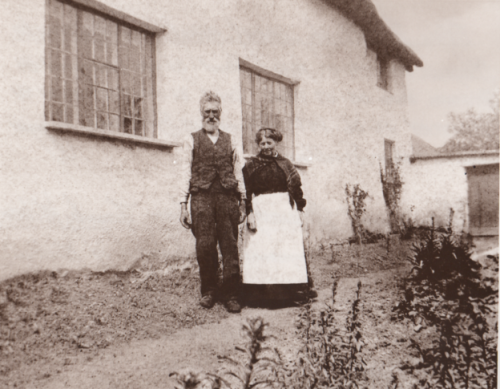
And this photo below is of their final resting place in Stockleigh English churchyard.

Thomas Graham’s death was reported in the local newspaper (Western Times, Image © Trinity Mirror. Image created courtesy of THE BRITISH LIBRARY BOARD. Image reproduced with kind permission of The British Newspaper Archive (www.britishnewspaperarchive.co.uk).
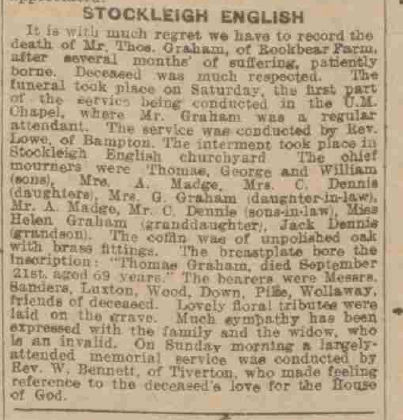
Donald Graham, who has been the informant of this wonderful story, remembers his grandfather telling him about Thomas and Marion Graham. He remembered that Thomas Graham was a very tall man with a great bushy beard and strong Scots accent. His Granny Marion, by comparison, was a small woman who was dwarfed by her husband. Marion had a strong character and was proud of her Scottish background and is also remembered for always greeting her grandchildren with a bag of sweets.
Thomas and Marion Graham’s story is fascinating. They were part of the Scottish migration of shepherds from Scotland to Exmoor and their life took them to Larkbarrow and Badgworthy high up on Exmoor hills; to Kipscombe at Countisbury and to Twitchen Farm at Challacombe and finally to South Devon, where they ended their days still living and working on farms near their children in Crediton.
Their story has survived to be retold today. A testimony to Marion Graham nee Wilson of Biggar in Lanarkshire, Scotland who came with her husband Thomas Graham to Exmoor in North Devon, determined, so we are told, to remember their Scottish roots and to pass on her pride and passion for those roots to her family. It seems safe to say she more than succeeded, because without her fierce pride and determination we wouldn’t have their story to share now.
Thank you to Donald Graham for getting in touch and sharing another wonderful story about the Scottish shepherd families on Exmoor. He is keen to find more relatives or anyone else who may know more of his Graham family either in and around Devon or in and around Biggar in Scotland. If you would like to learn more from Donald Graham or have something to share please do get in touch

2 thoughts
My ancestors were also John Graham and Janet Steel through their son James Graham who was the Station Carter in Biggar. My great grandfather was George Graham who had a hardware shop in Glasgow. My grandmother Daisy Graham married into the Milne Family and my mother Shona Milne married into the Clark Family. I had a lot of trouble trying to find out about the Graham Family before the 1860s, and my wife came across your website. Very interesting site and it explains why I had so much trouble tracking down John’s death certificate!
Hello Neil – I apologise if your comment has been up here for a while and I’ve not replied but its great to hear from you and I know Donald Graham, down here in Somerset, who shares your descent would love to hear from you. Can you email me on bette.baldwin@btinternet.com and I could link the two of you up. Many thanks. Bette
Comments are closed.